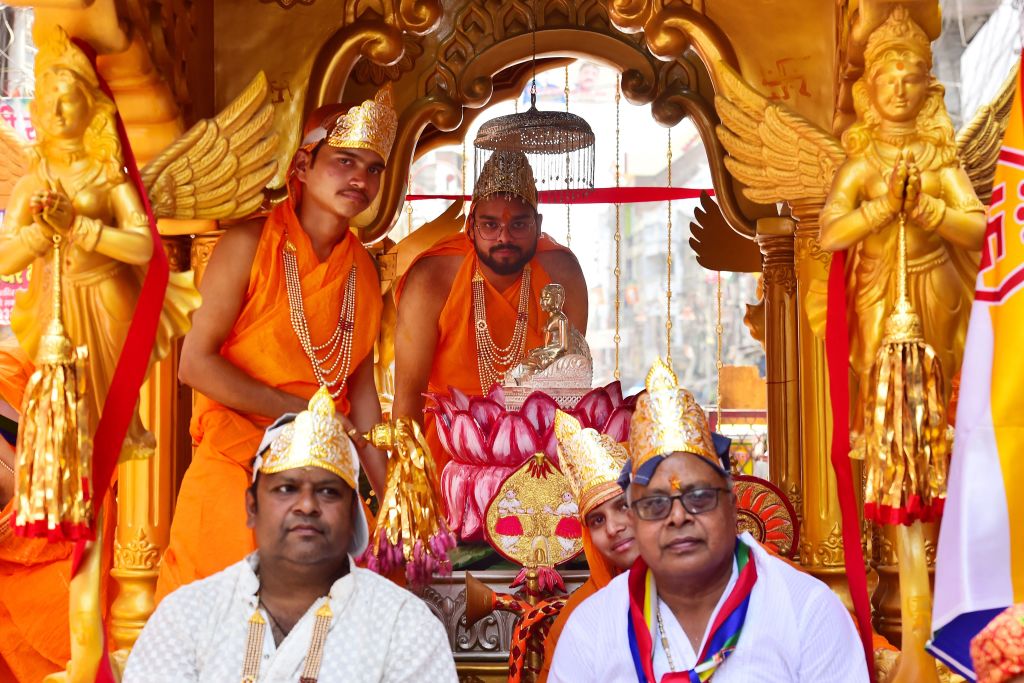As an LGBTQ+ Jain, I felt completely invisible growing up. Now, I want to give back

Henish’s strand of Jainism preaches acceptance of all people. (Getty)
Henish* is a 19-year-old London-based ambassador for LGBTQ+ young people’s charity Just Like Us. Here, he shares the story of his struggle to find representation growing up queer in the Jain community.
Amidst the whirling of colourful garments as people spun and danced around the murti (statue), amidst the rhythm of the dhol (double-sided barrel drum) and the ethereal singing, at this garba I suddenly felt incredibly alone. This was somewhere I felt so at home, but simultaneously so different and out of place.
Garba is a Gujarati traditional dance, heavily linked to my religion of Jainism. But as younger me found out with a quick Google search one night, the intersection between the worlds of queerness and Jainism is almost completely invisible.
Jainism is a small religion mainly found in the north-west of India with about 65,000 followers in the UK, and as such, it is quite an insular community. Growing up, it was a huge part of my life: I often attended community gatherings like satsangs and the garbas within my small religious group, and I regularly participated in seva – literally translating to ‘selfless volunteering’, which was in this case religious.
The strand of Jainism I follow does not have any necessarily queerphobic views. It preaches acceptance of all people. However, most Jains teach that sexual attraction is wrong. Growing up gay, this preyed on my mind. I shunned that part of my identity away to the point where I almost forgot about it. When I was asked if I was gay at school (as schoolboys do), I remember laughing – but I have no recollection of actually considering the question. It was as if some amnesia had overtaken me, where I had been ashamed of my queer identity and shunned it to the point where I no longer had any recollection of it. I thought my feelings were disgusting and unnatural. I was repulsed by myself.
You may think at this point that there is nothing in my religion that would make me feel this way about being gay, and you would be right. The crux of the issue was representation. All around me were straight couples – mums and dads, ladki and ladka (girls and boys), grandmas and grandpas – but nowhere were there anywhere like me. Or at least there was nobody visible. Add to this the latent homophobia in my very traditional community imported by the British Empire, and you begin to create a toxic environment for queer people.

I could not even attach a label to what I felt until around the age of 14, when I was taught about the LGBTQ+ community at school. Even then, it took at least three years to even accept myself and decide to come out to someone. Through endless Google searches about Jainism and queerness, I could not find anything mentioning that I could exist. I was isolated in my little intersection.
Even after coming out, it took until university to bring these two identities together and to live as my whole self, and that is all thanks to one thing: representation. During freshers’ week, I attended my first ever LGBTQ+ event, and I was terrified. As I walked in, I joined a group to try and make some friends, and I was shocked, there were people that were South Asian and LGBTQ+?
What might seem silly now was a huge revelation to me, people like me did exist in the world. They may not have been Jain, but that was close enough for me. In that moment I realised how important representation was. My whole identity had just been validated. I understood that, as I knew nobody like me that existed and had nobody to look up to in that sense, I needed to carve out my own identity. I needed to define by myself what it meant to be queer and Jain, and the way to define that identity was by living it. I did not need to conform to a definition, instead whoever I was would be the definition. To do this I also understood that I had to take back control of my spirituality, come up with my own interpretations, and define what Jainism meant to me personally rather than let the community tell me what I should or should not do or be.
Most importantly, I understood that I had to make our intersection visible, so that others would not have this same experience. That’s when my friend forwarded me an Instagram post from Just Like Us: “We need volunteers.” Upon reading that I could be giving talks in schools, that I could be providing that same representation I so sorely needed growing up, that I had the potential to change lives, I immediately signed up – and here I am today! I may not have found people exactly like me yet, but I aspire to not let future generations go through what I had to.
I hope that in the future queer Jains can flourish in their authentic identities from day one, and I hope we can all feel that we truly belong in the twirling circles of the garba.
*name has been changed
Browsing on your phone? Click here to join our new PinkNews Alerts WhatsApp group for daily digests of the hottest LGBTQ+ news and features.
How did this story make you feel?

